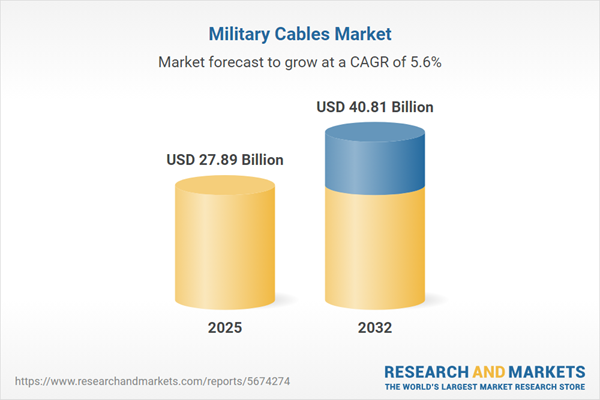Speak directly to the analyst to clarify any post sales queries you may have.
Military cable systems form the backbone of secure defense communications, supporting critical data exchange and operational reliability in environments where resilience is non-negotiable. As connectivity requirements and technological innovations accelerate, possessing a clear understanding of the global military cables market is essential for senior industry stakeholders.
Market Snapshot: Military Cables Market Size and Growth Outlook
The military cables market grew from USD 26.38 billion in 2024 to USD 27.89 billion in 2025 and is projected to reach USD 40.81 billion by 2032, demonstrating a CAGR of 5.60%. This sustained expansion reflects rising investments in modernization, multi-domain operations, and robust digital infrastructure for defense applications globally.
Scope & Segmentation of the Military Cables Market
Comprehensive analysis in this report covers the full spectrum of military cable technologies, deployment scenarios, and supply chain impacts. Coverage spans product innovations, procurement strategies, and defense-sector requirements across diverse geographies.
- Cable Types: Armored cable (double armored and single armored), coaxial cable, fiber optic cable (multi-mode and single-mode), shielded twisted pair cable
- Applications: Communication, control and signaling, high-frequency, power transmission
- End Users: Aerospace, defense forces, naval
- Regional Coverage: Americas (United States, Canada, Mexico, Brazil, Argentina, Chile, Colombia, Peru), Europe, Middle East & Africa (United Kingdom, Germany, France, Russia, Italy, Spain, Netherlands, Sweden, Poland, Switzerland, United Arab Emirates, Saudi Arabia, Qatar, Turkey, Israel, South Africa, Nigeria, Egypt, Kenya), Asia-Pacific (China, India, Japan, Australia, South Korea, Indonesia, Thailand, Malaysia, Singapore, Taiwan)
- Key Companies: TE Connectivity Ltd., Amphenol Corporation, Prysmian S.p.A., Nexans S.A., Carlisle Companies, Inc., Belden Inc., Leoni AG, Sumitomo Electric Industries, Ltd., Hengtong Optic-Electric Co., Ltd., Molex LLC
Key Takeaways for Senior Decision-Makers
- Modern defense communications require cables engineered for harsh environments, with advanced shielding and resilient sheathing to maintain integrity under climatic and operational stressors.
- Innovation in materials science and hybrid cable architectures is meeting evolving needs for miniaturization, higher bandwidth, and integration with autonomous vehicles and tactical networks.
- Collaborative product development—between procurement authorities, technical experts, and academia—ensures that new cable solutions meet rigorous qualification protocols and adapt to shifting operational demands.
- Regional defense initiatives are fueling demand for both locally manufactured and globally standardized cable systems, adapting to unique environmental and interoperability challenges.
- Ongoing digital transformation in military operations intensifies the importance of modular upgrades, secure lifecycle management, and proactive investment in next-generation connectivity infrastructure.
Tariff Impact: Navigating Regulatory and Supply Chain Disruption
Recent United States tariff measures on imported raw materials have increased production costs in several military cable segments, compelling contractors to invest in domestic manufacturing and diversify sourcing. Alternative alloys and recycled metals are gaining traction as cost-stable, performance-validated options. Defense agencies are also updating procurement and qualification frameworks to accommodate these material adjustments, supporting long-term supply chain resilience in the face of evolving regulatory landscapes.
Military Cables Market: Methodology & Data Sources
This analysis is grounded in a blend of comprehensive secondary source review—including procurement records, technical standards, and patent filings—and qualitative primary research. In-depth interviews with integrators, suppliers, and technical end users validate current industry trends, while quantitative surveys capture comparative performance metrics. Data triangulation and quality checks ensure robust data integrity and actionable findings.
The Military Cables Market: Why This Report Matters
- Enables informed investment and sourcing strategies by providing transparent analysis of technological, regulatory, and regional market trends.
- Supports risk management in procurement and supply chain logistics, identifying emerging challenges and actionable mitigation pathways.
- Provides a benchmarking tool for evaluating current product offerings and partnership opportunities in a competitive global landscape.
Conclusion
Military cable systems act as critical enablers of modern defense operations and interconnectivity. This report equips stakeholders to anticipate risks, harness technological progress, and support operational readiness through sharper, data-driven procurement and investment choices.
Additional Product Information:
- Purchase of this report includes 1 year online access with quarterly updates.
- This report can be updated on request. Please contact our Customer Experience team using the Ask a Question widget on our website.
Table of Contents
3. Executive Summary
4. Market Overview
7. Cumulative Impact of Artificial Intelligence 2025
Companies Mentioned
The companies profiled in this Military Cables market report include:- TE Connectivity Ltd.
- Amphenol Corporation
- Prysmian S.p.A.
- Nexans S.A.
- Carlisle Companies, Inc.
- Belden Inc.
- Leoni AG
- Sumitomo Electric Industries, Ltd.
- Hengtong Optic-Electric Co., Ltd.
- Molex LLC
Table Information
| Report Attribute | Details |
|---|---|
| No. of Pages | 198 |
| Published | October 2025 |
| Forecast Period | 2025 - 2032 |
| Estimated Market Value ( USD | $ 27.89 Billion |
| Forecasted Market Value ( USD | $ 40.81 Billion |
| Compound Annual Growth Rate | 5.6% |
| Regions Covered | Global |
| No. of Companies Mentioned | 11 |









